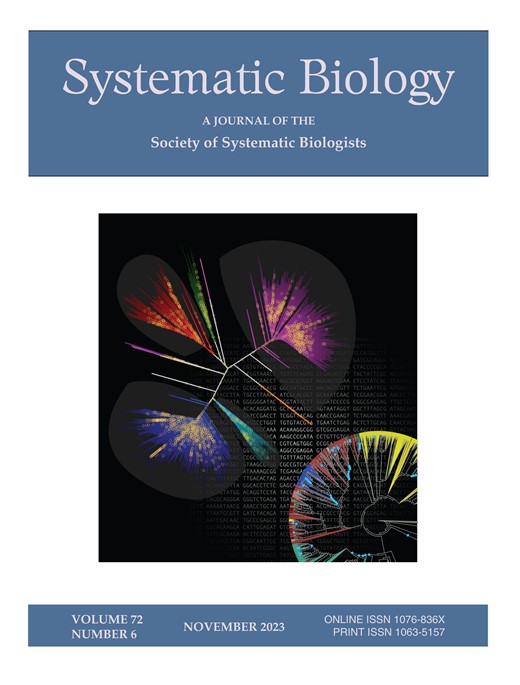PlaceMyFossils: An Integrative Approach to Analyze and Visualize the Phylogenetic Placement of Fossils Using Backbone Trees.
IF 5.7
1区 生物学
Q1 EVOLUTIONARY BIOLOGY
引用次数: 0
Abstract
In recent years, there has been a growing interest in using morphology to establish the placement of species on phylogenetic trees derived from molecular data. This is relevant in the case of recently extinct or fossil species, which are usually represented only by fragmentary morphology. In the latter case, constrained analyses using backbone trees have also proven helpful in evaluating the placement of fragmentary specimens on phylogenetic trees derived from morphological data. Consequently, several available phylogenetic programs now include functions to run constrained searches. However, a comprehensive evaluation of the obtained results is not readily available within existing analytical tools. Here, we present an integrated approach-PlaceMyFossils-specifically designed to (1) thoroughly evaluate the phylogenetic placement of given query species (especially fossils) on a reference tree, (2) determine which characters and character partitions are most relevant in defining the phylogenetic placement, (3) assess the confidence of the results, and (4) define the optimal analytical conditions to place the query species. PlaceMyFossils combines several analyses implemented as an interactive script for TNT (Tree Analysis Using New Technologies software), a popular-and free-phylogenetic software that is widely used in paleontological studies. Finally, we demonstrate the utility and investigate the performance of PlaceMyFossils compared to other available tools using two disparate empirical datasets drawn from conifers and dinosaurs. While primarily designed for working with fossils, this tool also holds great potential for advancing morphological and molecular systematics. It offers a powerful resource for empirical systematists aiming to integrate molecular and morphological data. This is particularly relevant given the growing interest in morphological evolution as a complementary perspective on evolutionary processes and the drivers of diversification.PlaceMyFossils:一个综合的方法来分析和可视化化石的系统发育位置使用骨干树。
近年来,人们对利用形态学来确定物种在分子数据衍生的系统发育树上的位置越来越感兴趣。这与最近灭绝的物种或化石物种有关,这些物种通常仅由碎片形态表示。在后一种情况下,使用骨干树的约束分析也被证明有助于评估来自形态学数据的系统发育树上的碎片标本的位置。因此,一些可用的系统发育程序现在包含运行约束搜索的功能。然而,在现有的分析工具中,很难对所获得的结果进行全面的评价。在这里,我们提出了一种集成方法——placemyfossils——专门用于(1)彻底评估给定查询物种(特别是化石)在参考树上的系统发育位置,(2)确定哪些字符和字符分区与定义系统发育位置最相关,(3)评估结果的置信度,以及(4)定义放置查询物种的最佳分析条件。PlaceMyFossils将几种分析结合为TNT(使用新技术的树分析软件)的交互式脚本,TNT是一种广泛用于古生物学研究的流行且免费的系统发育软件。最后,我们展示了PlaceMyFossils的实用性,并利用来自针叶树和恐龙的两个不同的经验数据集,研究了它与其他可用工具的性能。虽然主要是为研究化石而设计的,但这个工具在推进形态学和分子系统学方面也有很大的潜力。它为旨在整合分子和形态数据的经验系统学家提供了强大的资源。鉴于形态进化作为进化过程和多样化驱动因素的补充观点日益受到关注,这一点尤为重要。
本文章由计算机程序翻译,如有差异,请以英文原文为准。
求助全文
约1分钟内获得全文
求助全文
来源期刊

Systematic Biology
生物-进化生物学
CiteScore
13.00
自引率
7.70%
发文量
70
审稿时长
6-12 weeks
期刊介绍:
Systematic Biology is the bimonthly journal of the Society of Systematic Biologists. Papers for the journal are original contributions to the theory, principles, and methods of systematics as well as phylogeny, evolution, morphology, biogeography, paleontology, genetics, and the classification of all living things. A Points of View section offers a forum for discussion, while book reviews and announcements of general interest are also featured.
 求助内容:
求助内容: 应助结果提醒方式:
应助结果提醒方式:


